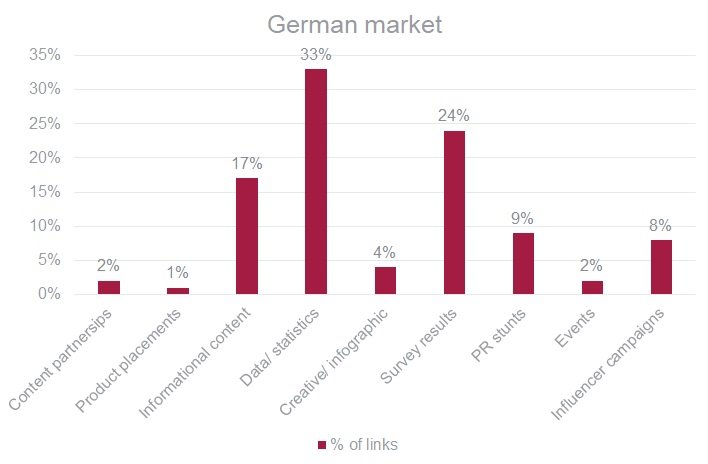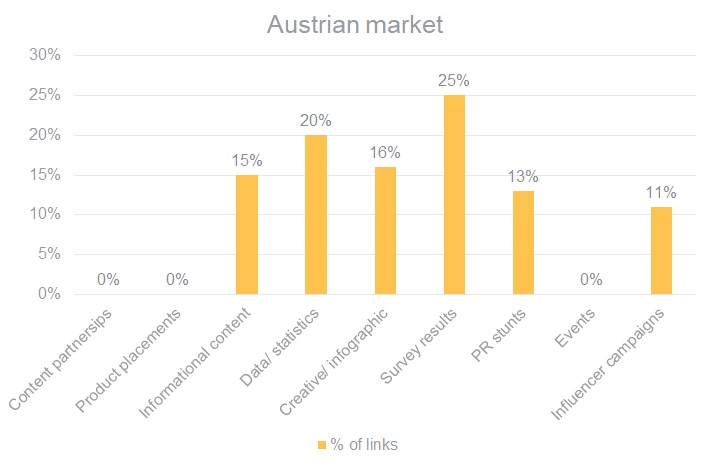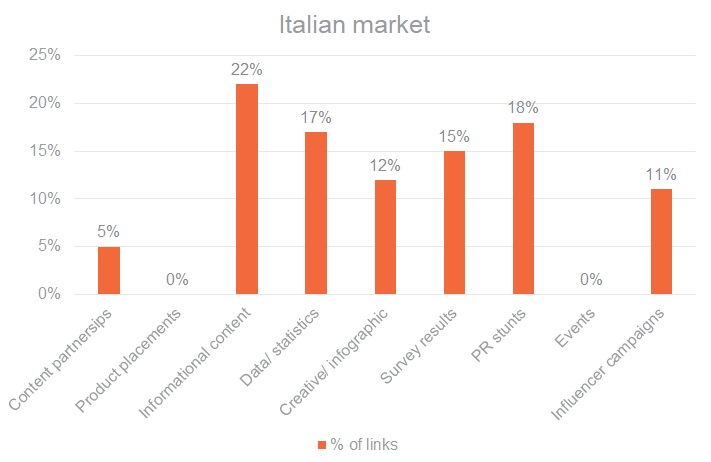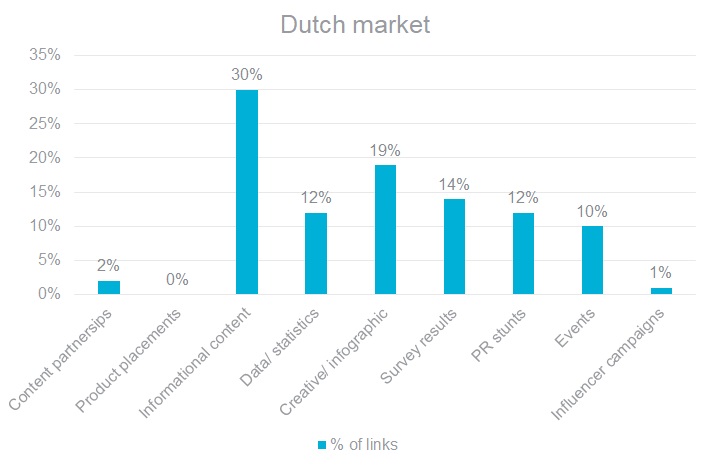
![]() Insights
Insights
Building a strong brand is the key to success when entering new markets, and one of the most effective ways to get your brand out there is by running localised digital PR campaigns.
While some English-speaking campaigns can work in multiple markets, we have found that there are key differences in the types of stories which get covered internationally; it is often best to create market-specific campaigns or at least revamp the data and angle before localising and sending out.
We use a bespoke, in-house-developed tool called LinkLab, which our digital PR team use to track the success of campaigns and manage our media relationships.
To better understand the types of campaigns different markets prefer to cover, we analysed two years of LinkLab data across some of the markets we work in.
We categorise our campaigns in LinkLab into the following:

There are several differences between the UK and France when it comes to digital PR, but one of the key factors that needs to be considered is that France has a much more serious media landscape – many of the fun, light-hearted campaigns that work so well in the UK tend to flop in France.
Strongly researched and informative thought leadership content which contains data and statistics, as well as input from recognised experts, tends to perform best in French media:
75% of the links we have obtained in the French market came from long-form written content such as whitepapers, or as a result of strong relationships the team has built with journalists and publishers.

A successful digital PR strategy for the French market involves building your brand up so that it is seen as a credible authority on the topic you wish to get known for. In-depth thought leadership pieces which are well researched and show your expertise in the area has the benefit of creating authority and getting media coverage and links.
Media relations are also important for building up trust and investing in relationship management with key journalists will help to secure ongoing coverage in France for your brand. Spelling, grammar, and structure are very important here too – journalists in France will rarely respond to a poorly constructed email or campaign, and as a rule of thumb outreach should always be carried out in formal language.
Like French publications, media outlets in Germany are less interested in creative and “fun” stories – they prefer hard-hitting press releases backed up by data:
61% of our links came from data-led PR campaigns including data-led news stories, strong survey results and informational content which was backed up by data and sources.

The key to getting your story covered in Germany is having strong data which packs a punch – press releases containing shocking headlines which are backed up by statistics is well received in this market. Informational content when backed up by credible sources also performs well, but again – data is key.
One thing that stands out in this market is that it is not essential to build relationships with journalists in Germany; in fact, it is very unusual to have “friends” or go-to contacts in German publications. Rather than put brands at a disadvantage, this means that a good story – regardless of who it is from – will get its due coverage. Keep outreach short and to the point and include a well-written press release so that it is easy for journalists to pick up on what exactly the story is, and always use formal language in the first instance – from there, it is fine to switch to informal if that is what the journalist uses.
Austria and Germany share the same language and as a result, we often see brands targeting both countries with the same campaigns. There are actually many differences between the two countries (which we cover more here), including which campaigns are most likely to be covered.
Like in Germany, data-driven stories perform best in Austria. However, there is a greater emphasis on survey results (when sampled on the Austrian population) than on general statistics. A lot of news stories and PR content in Austria is geared at neighbouring Germany, so it makes sense that surveys which are carried out on and tailored to Austrians perform so well.

The best way to get links and establish your brand as an authority in the Austrian market is to gather data on a country level, rather than using results from Germany or other markets. When carrying out surveys, commission a company which can get Austria-specific results.
It is also important to use credible sources from Austria if you choose to bring in an expert or thought leader as a source or quote for your story.
The Italian media is more like the UK than the markets we have just touched on; they respond positively to informal outreach and are more open to receiving creative and visual campaigns.
That being said, data is still important here: 44% of our links from the past two years came from data-driven campaigns. When we break down these campaigns, it is clear that visual and creative formats informed by data perform just as well as long-form content and press releases.

When coming up with campaign ideas for the Italian market, be creative! Once you have a concept, think about the various formats you can use to bring the idea to life – what types of content does your target publishers usually cover?
The Dutch media is receptive to most campaign types, with our links from the last two years coming from a fairly even spread over the different types of digital PR campaigns (although informational content campaigns come out slightly on top).
PR stunts, events and more creative campaigns had a much higher rate of links in The Netherlands than anywhere else we have looked at, which in part has been down to its central location in Europe and its largely English-speaking community – making it an ideal market to host large multinational events.

The Dutch media is open to receiving stories in multiple formats, which means all you need to do is come up with a strong story, decide which type of campaign works best for your brand, and ensure the research, stats and content is fully localised for this market.
Localising your campaigns (both the idea and the execution) is key to getting national coverage in different international markets. Within each market, different sectors and media types will have their own preferences, but hopefully, this data will be a useful starting point when planning your international campaigns.
We have previously written a step by step guide to planning international PR campaigns which can be found here.
We can help with your international expansionGet in touch

![]() Insights
Insights

![]() Insights
Insights

![]() Insights
Insights